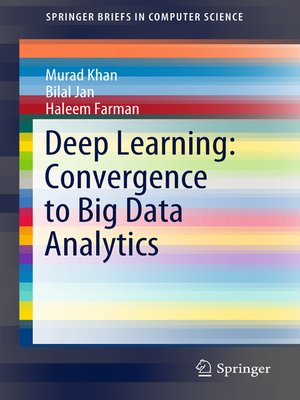
The Science of Deep Learning | 362 | Iddo Drori | 2018 | Springer Nature Singapore | 9789811334580
This book presents deep learning techniques, concepts, and algorithms to classify and analyze big data. Further, it offers an introductory level understanding of the new programming languages and tools used to analyze big data in real-time, such as Hadoop, SPARK, and GRAPHX. Big data analytics using traditional techniques face various challenges, such as fast, accurate and efficient processing of big data in real-time. In addition, the Internet of Things is progressively increasing in various fields, like smart cities, smart homes, and e-health. As the enormous number of connected devices generate huge amounts of data every day, we need sophisticated algorithms to deal, organize, and classify this data in less processing time and space. Similarly, existing techniques and algorithms for deep learning in big data field have several advantages thanks to the two main branches of the deep learning, i.e. convolution and deep belief networks. This book offers insights into these techniques and applications based on these two types of deep learning.
Further, it helps students, researchers, and newcomers understand big data analytics based on deep learning approaches. It also discusses various machine learning techniques in concatenation with the deep learning paradigm to support high-end data processing, data classifications, and real-time data processing issues.
The classification and presentation are kept quite simple to help the readers and students grasp the basics concepts of various deep learning paradigms and frameworks. It mainly focuses on theory rather than the mathematical background of the deep learning concepts. The book consists of 5 chapters, beginning with an introductory explanation of big data and deep learning techniques, followed by integration of big data and deep learning techniques and lastly the future directions.
The Science of Deep Learning emerged from courses taught by the author that have provided thousands of students with training and experience for their academic studies. prepared them for careers in deep learning, machine learning. artificial intelligence in top companies in industry and academia. The book begins by covering the foundations of deep learning, followed by key deep learning architectures. Subsequent parts on generative models and reinforcement learning may be used as part of a deep learning course or as part of a course on each topic. The book includes state of the art topics such as Transformers, graph neural networks, variational autoencoders. deep reinforcement learning, with a broad range of applications. The appendices provide equations for computing gradients in backpropagation and optimization. best practices in scientific writing and reviewing. The text presents an up to date guide to the field built upon clear visualizations using a unified notation and equations, lowering the barrier to entry for the reader. The accompanying website provides complementary code and hundreds of exercises with solutions.
------------------------------------*****------------------------------------
NitroFlare Link(s) (Premium Link)
Code:
Linkeket csak regisztrált tagok láthatják! Bejelentkezés ::: Regisztráció
Code:
Linkeket csak regisztrált tagok láthatják! Bejelentkezés ::: Regisztráció

